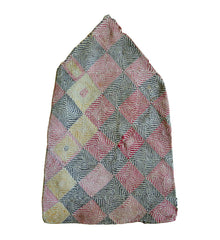A Fully Embroidered Small Kantha Coin Purse: Whorls
$115.00 USD
ca. mid twentieth century
13 1/2" x 8 1/2", 34 cm x 21.5 cm
This is an amazingly beautiful--almost mesmerizing--small cotton bag
hand stitched in West Bengal, India, using a stitching method called kantha.
Kantha stitching has its roots in ingenuity and the culture of women: used white dhotis (men's sarongs) and women's sarees
were salvaged, cut and layered: thread from the colored, embroidered
borders of the used garments were pulled free from the rags and used as
embroidery threads for quilted work, the border threads usually being
black and red, blue and red, and sometimes yellow, orange and green.
Quilts, bags and clothing were embroidered using a running, stem and satin stitch, the quilts and coverlets were constructed of many layers, the number of layers dependent of the weather of the region where a particular kantha was stitched.
Quilts, bags and clothing were embroidered using a running, stem and satin stitch, the quilts and coverlets were constructed of many layers, the number of layers dependent of the weather of the region where a particular kantha was stitched.
This small bag or pouch is said to be a coin bag that is
fashioned from a square-shaped embroidered cotton cloth. The all over,
hand
stitching in red, grey and yellow cotton thread is fantastic, as is the wonderful design.
If you were to open this envelope shaped bag to show its square shape, you would see that the square textile would be a grid pattern. The whorling, fingerprint-like stitching that subdivide each of the grid squares into another four areas, is a variant on the shostir chino, a swastika like form that suggests the churning and constant motion of the universe.
This bag has been used hard as can be seen by (what appears to be) light fading to the embroidery threads, overall surface abrasion, and some some abrasion to the corners and edges of the bag.
A really lovely kantha bag.
Recommended.

